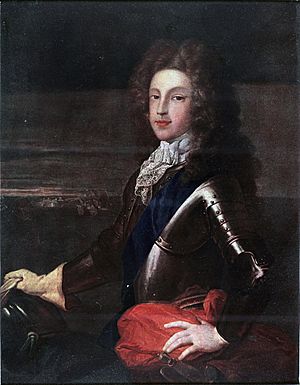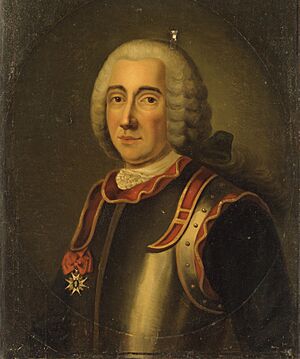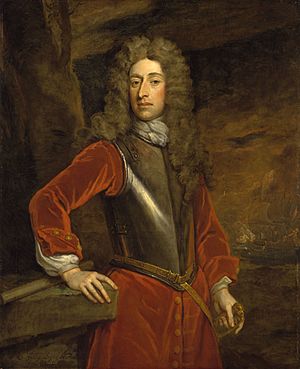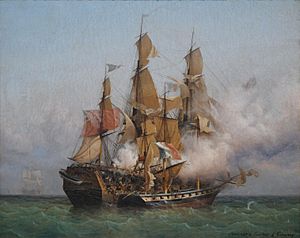Planned French invasion of Britain (1708) facts for kids
Quick facts for kids Planned French Invasion of Britain (1708) |
|||||||
|---|---|---|---|---|---|---|---|
| Part of the Jacobite risings and the War of the Spanish Succession | |||||||
 James Francis Edward Stuart, Unknown author |
|||||||
|
|||||||
| Belligerents | |||||||
| Commanders and leaders | |||||||
The Planned French Invasion of Britain in 1708 was also known as the Entreprise d’Écosse. It happened during the War of the Spanish Succession. The French planned to send 5,000 to 6,000 soldiers to Scotland. Their goal was to help Scottish Jacobites who wanted to put James Francis Edward Stuart back on the throne of Great Britain.
The French commander, Claude de Forbin, warned that it would be very hard to avoid the Royal Navy. Still, his fleet of small ships reached Scotland in March 1708. Just as he predicted, he could not land his soldiers. He had to return home, barely escaping the British navy chasing him.
These attempts showed that the French and the Stuarts had different goals. The Stuarts wanted their throne back. But for France, supporting the Stuarts was a cheap way to make Britain use its resources. A lot of the Royal Navy was busy chasing de Forbin. Also, British soldiers were moved from Ireland and Southern England. This made the invasion a success for France, but a failure for the Jacobites.
Why Did the Invasion Happen?
Under a peace treaty in 1697, Louis XIV of France had agreed that William III was the rightful king of England and Scotland. But in July 1701, the War of the Spanish Succession began. When James II died in September, Louis changed his mind. He said James's son, James Francis Edward Stuart, was the true king. William III died in March 1702. James's Protestant daughter, Anne, became queen.

By late 1707, the war was stuck. Even with wins in other places, the Allies could not break through French defenses. Both sides tried to use problems inside the other country to gain an advantage. Britain supported rebels in France. The Jacobites served a similar purpose for the French. They were a way to distract Britain.
A Jacobite agent named Nathaniel Hooke told Louis XIV that a Scottish uprising could work. This would make Britain move its soldiers away from Europe. The Union of 1707, which joined Scotland and England, was not popular in Scotland. French ships also caused huge losses for British trade and fishing. The Royal Navy had many jobs and did not always protect Scottish ships first.
Hooke visited Scotland in 1707. He met supporters like the Earl of Erroll. An older Jacobite, Thomas Buchan, gave reports on bases. Important nobles like the dukes of Atholl and Hamilton did not fully commit. This was partly because of a past attempt in 1703 by Simon Fraser to involve them in a Jacobite plot. However, Hooke got a letter of support. It was signed by Erroll and others. They promised 25,000 men and asked for 8,000 French soldiers, weapons, money, and officers to train the Scottish army.
Another Jacobite agent, John Ker, also claimed support from some Scottish religious groups. These groups felt the Union would bring many problems. They thought it would make Scots "slaves to the English." They saw the Union as a danger to the independence of the Church of Scotland. However, Ker was actually a British double agent. His job was to stop these groups from joining the Jacobites. By November 1707, Louis XIV decided there was enough support. Planning began, led by Pontchartrain. Claude de Forbin was chosen to lead the naval ships. The Comte de Gacé was in charge of the soldiers who would land.
The Journey to Scotland
The Royal Navy watched the French ports closely. So, naval operations often happened in winter. Strong winds and tides made it harder for the British to block the ports. But winter weather also made it more dangerous for the French. De Forbin was most worried about not having a safe place to land. He later wrote that the French minister did not name any port that could safely receive them.

Based on information from French captains, de Forbin told Pontchartrain and Louis XIV that the plan had no chance of success. But planning continued anyway. The French fleet gathered at Dunkirk. This was a major base for privateer ships. From Dunkirk, ships could reach the Thames River quickly. By the end of February, 5,000 to 6,000 soldiers were ready. James Stuart himself joined them on March 9.
Instead of slow transport ships, de Forbin insisted on using many small, fast privateer ships. These ships had fewer crew members and guns to make room for soldiers. This made it easier to avoid the Royal Navy. But it also meant they could not win a naval battle. The British knew about the preparations. A group of British ships led by Sir George Byng arrived near Gravelines. This stopped the French from leaving. James Stuart became ill with measles. So, the soldiers got off the ships while he recovered. After a week, Byng had to return to England for supplies. As soon as he left, James and the soldiers got back on board. On March 17, 30 privateer ships and five warships left Dunkirk.
Their departure was delayed by a two-day storm. But this storm also forced Byng to find shelter. This allowed the French to head for the Firth of Forth. Instead of staying close to the coast, de Forbin sailed far out to sea to avoid being seen. He ended up north of where they planned to land. On March 25, the French ships anchored near Fife Ness. They spent the next day looking for a landing spot. This gave Byng time to catch up. James protested, but the French privateers could not fight the British. They sailed north. They then spent two days trying to enter the Moray Firth before giving up. Most of them made it back to Dunkirk. The British chased them around the north of Scotland and west of Ireland. The French ships and men suffered a lot of damage.
When news of the French fleet arrived, some Jacobite gentlemen gathered. They were arrested and sent to prison in London. Later, they were moved to Edinburgh Castle. There, they were put on trial for a serious crime against the government.
What Happened Next?

How people saw the invasion's success depended on their goals. The Stuarts wanted to get their throne back. For the French, the Jacobites were a useful, low-cost way to make Britain use its resources. A Stuart king would not stop Britain from growing stronger.
The 1708 attempt was a response to France's difficult military situation. This was due to Marlborough's victories in other parts of Europe. The invasion kept many British and Dutch navy ships busy for several months. Byng was ordered to stay in Scotland even after the French left. Soldiers were also moved from Ireland and southern England. A French army of 110,000 soldiers recaptured parts of the Spanish Netherlands. But they were defeated again at the Battle of Oudenarde on July 11.
Even though the invasion failed to land troops, it achieved France's short-term goal of distracting Britain. However, it also helped the Whigs, who supported the war, win more votes. They won a majority in the May 1708 general election. This was the first election after the Union. The invasion also hurt the Jacobites. They failed to start a real uprising in Scotland, even though many people there did not like the Union. Hooke later wrote that the country seemed ready for peace.

